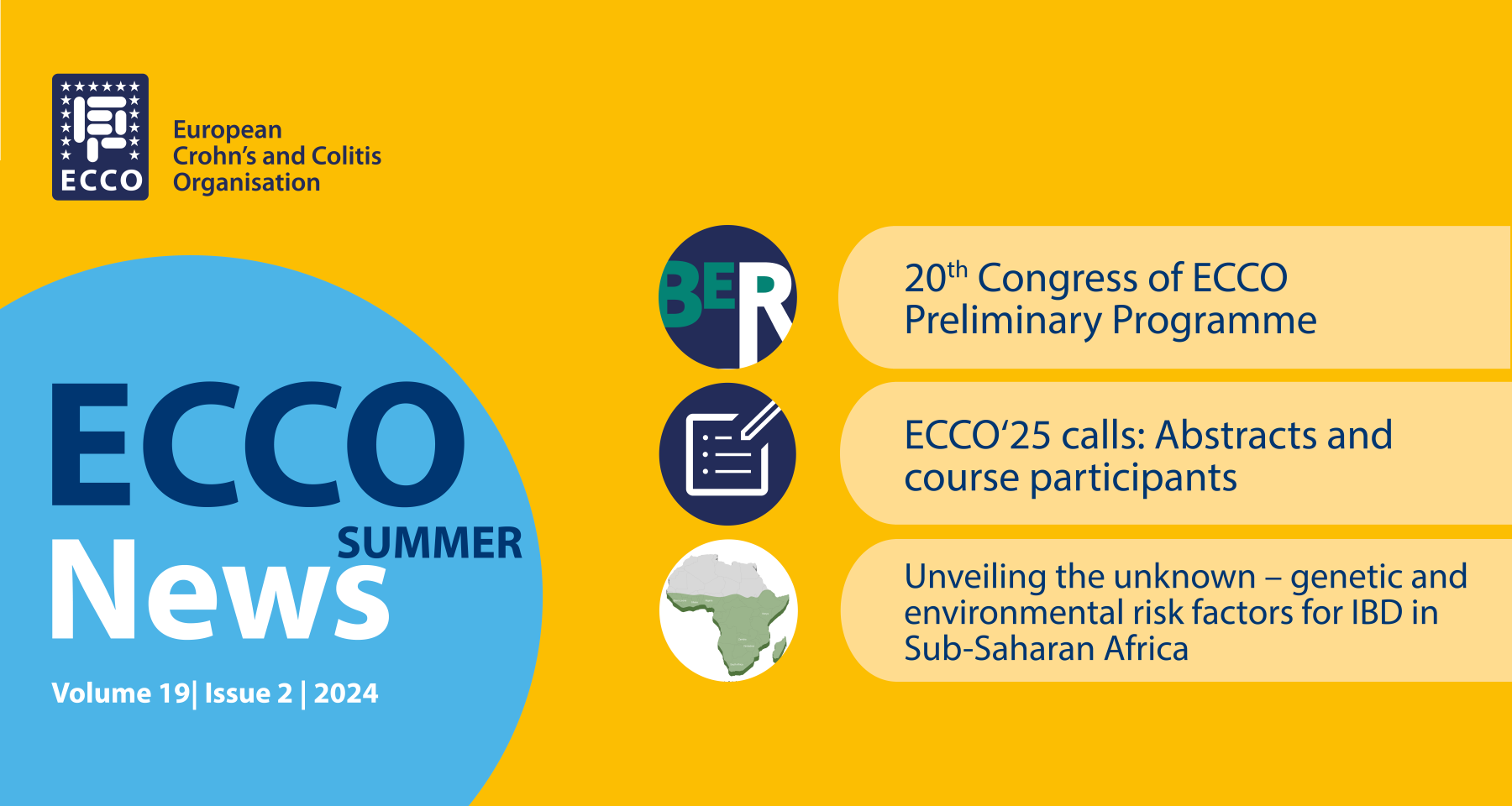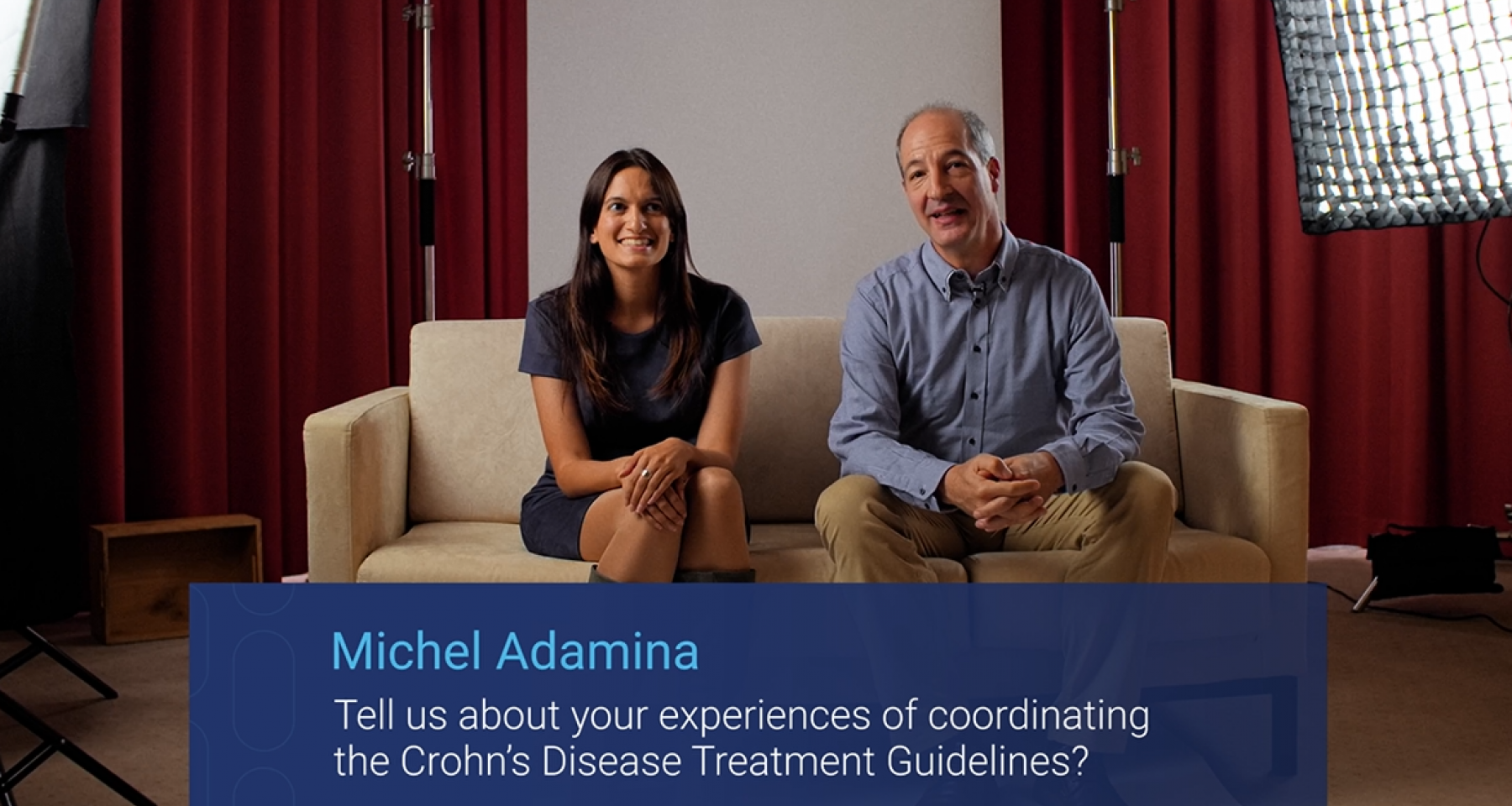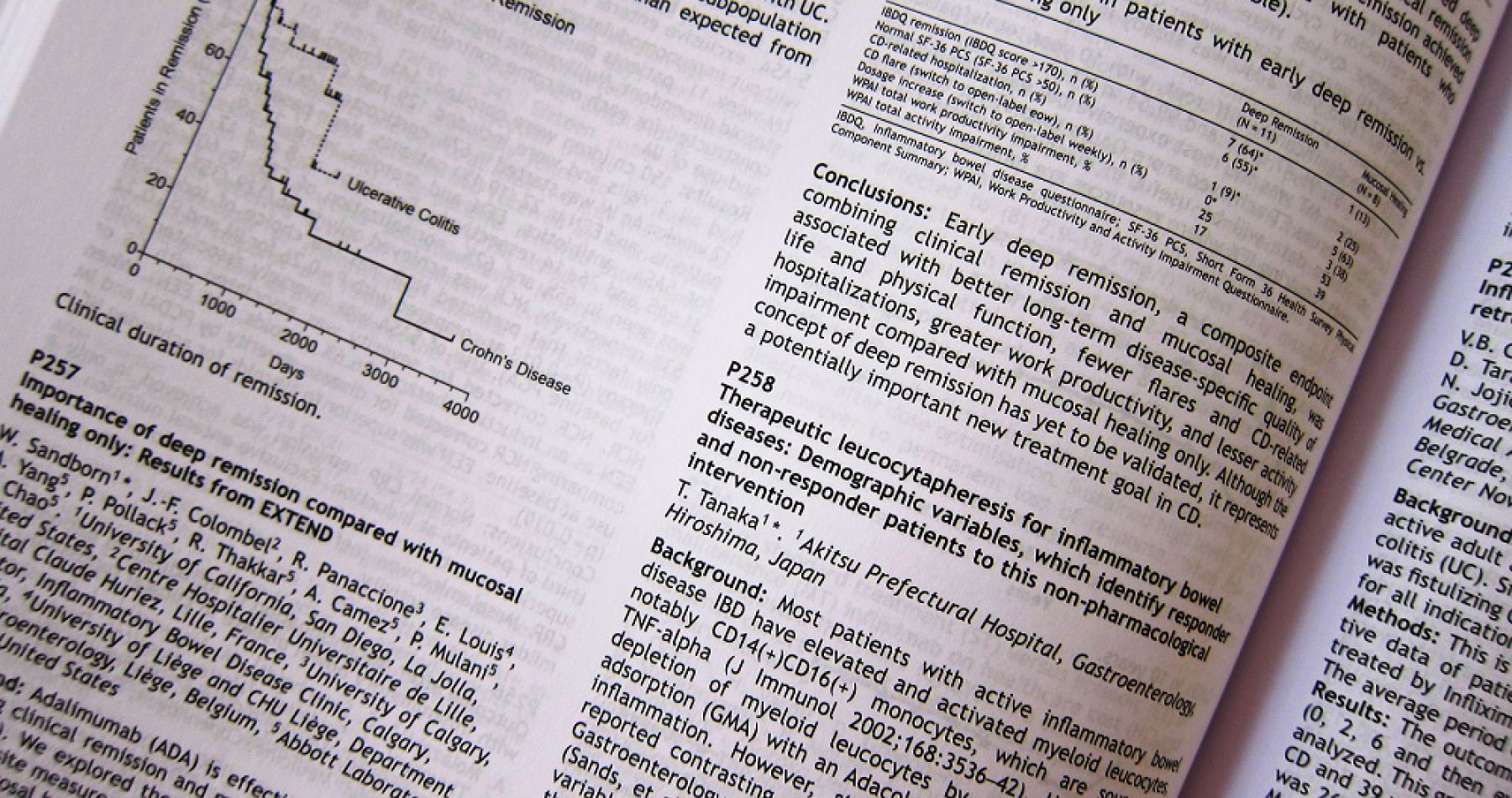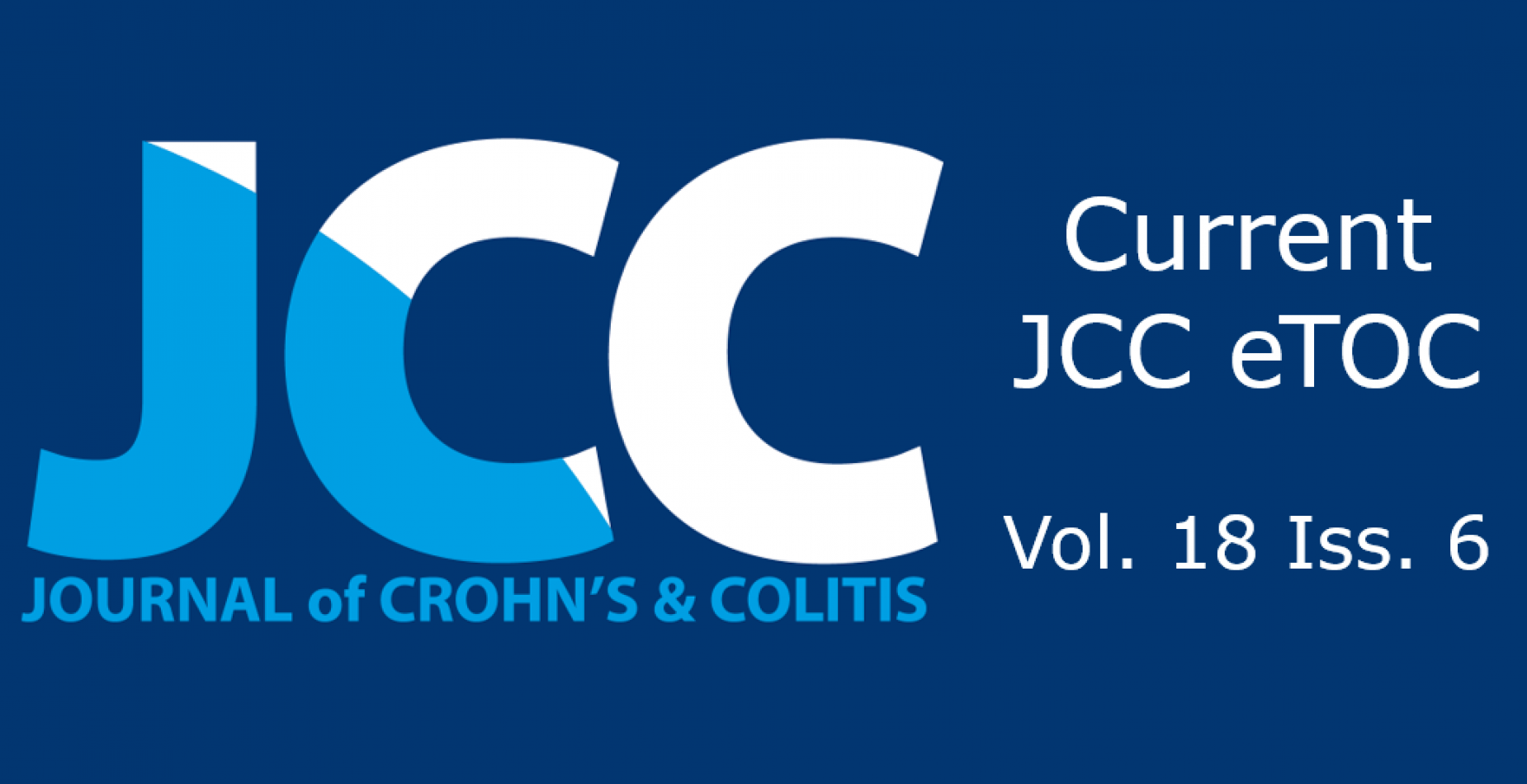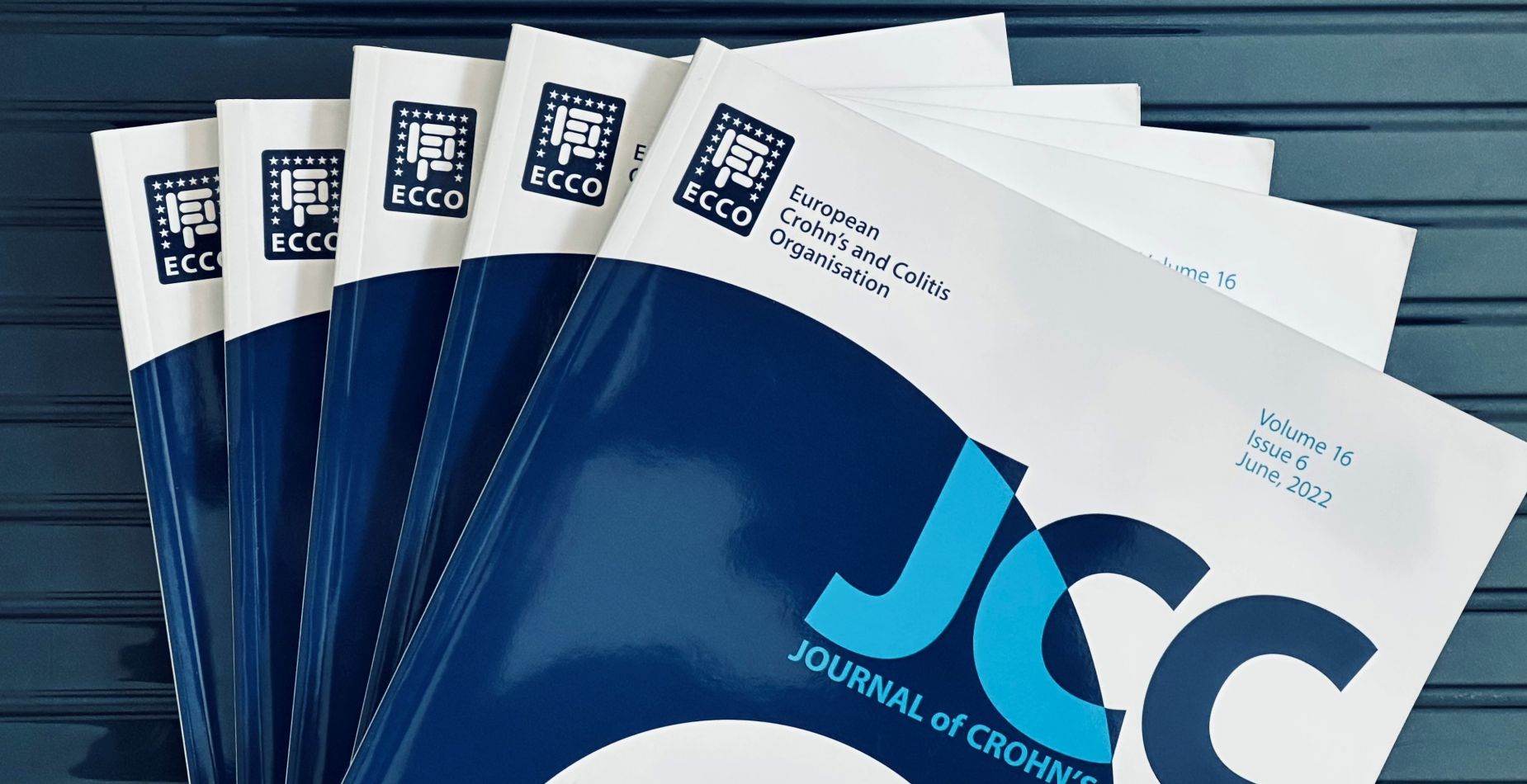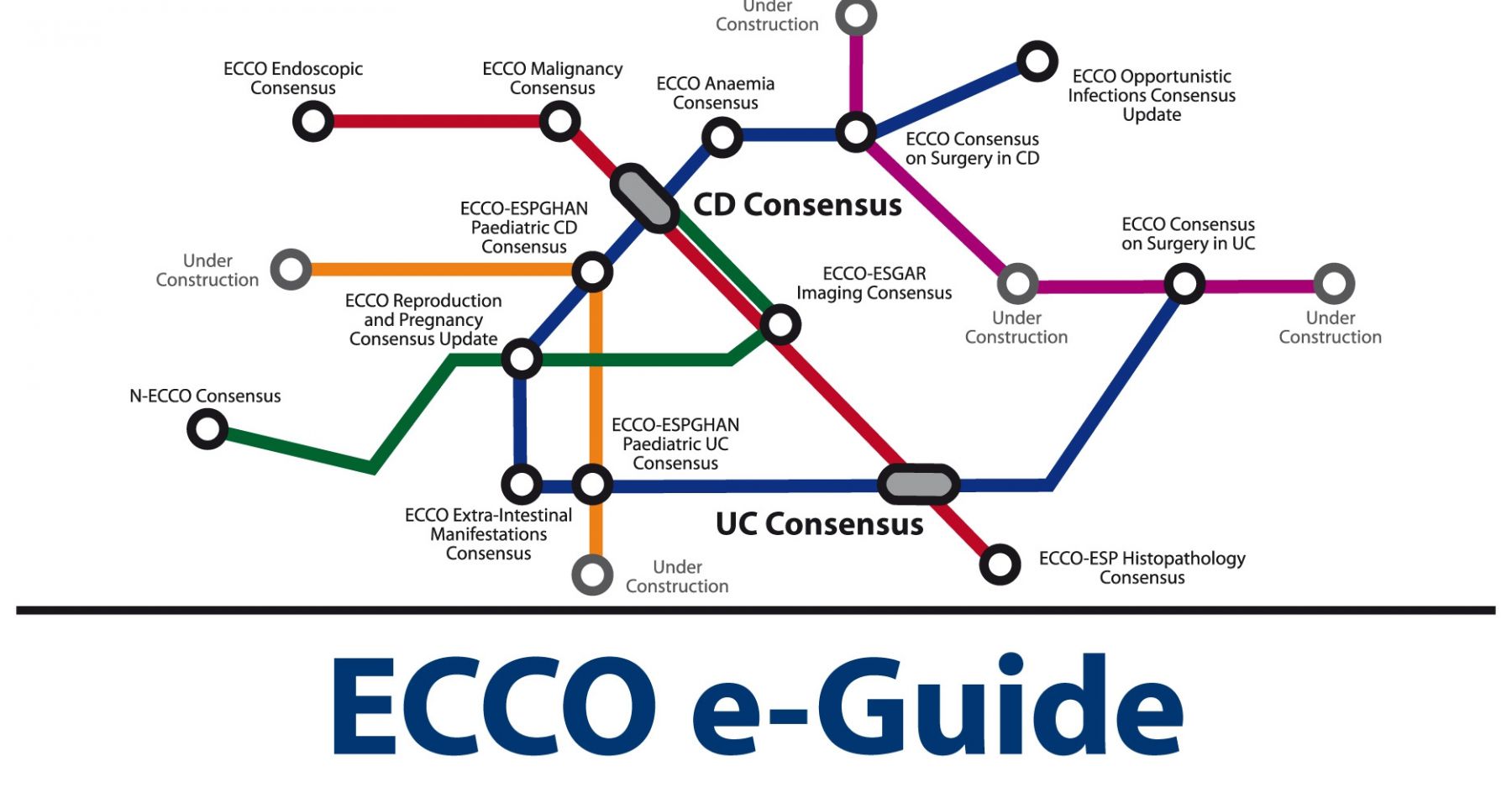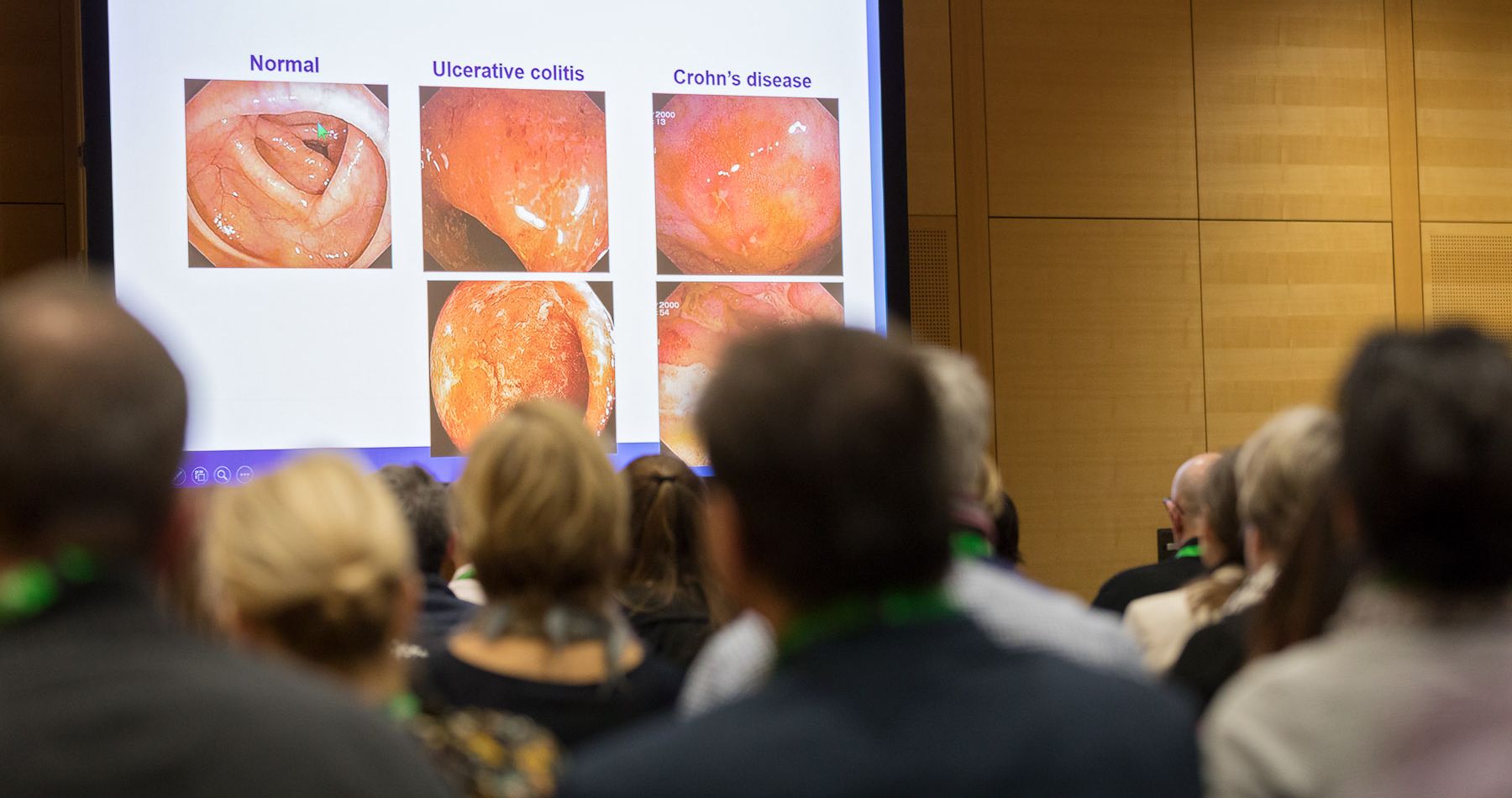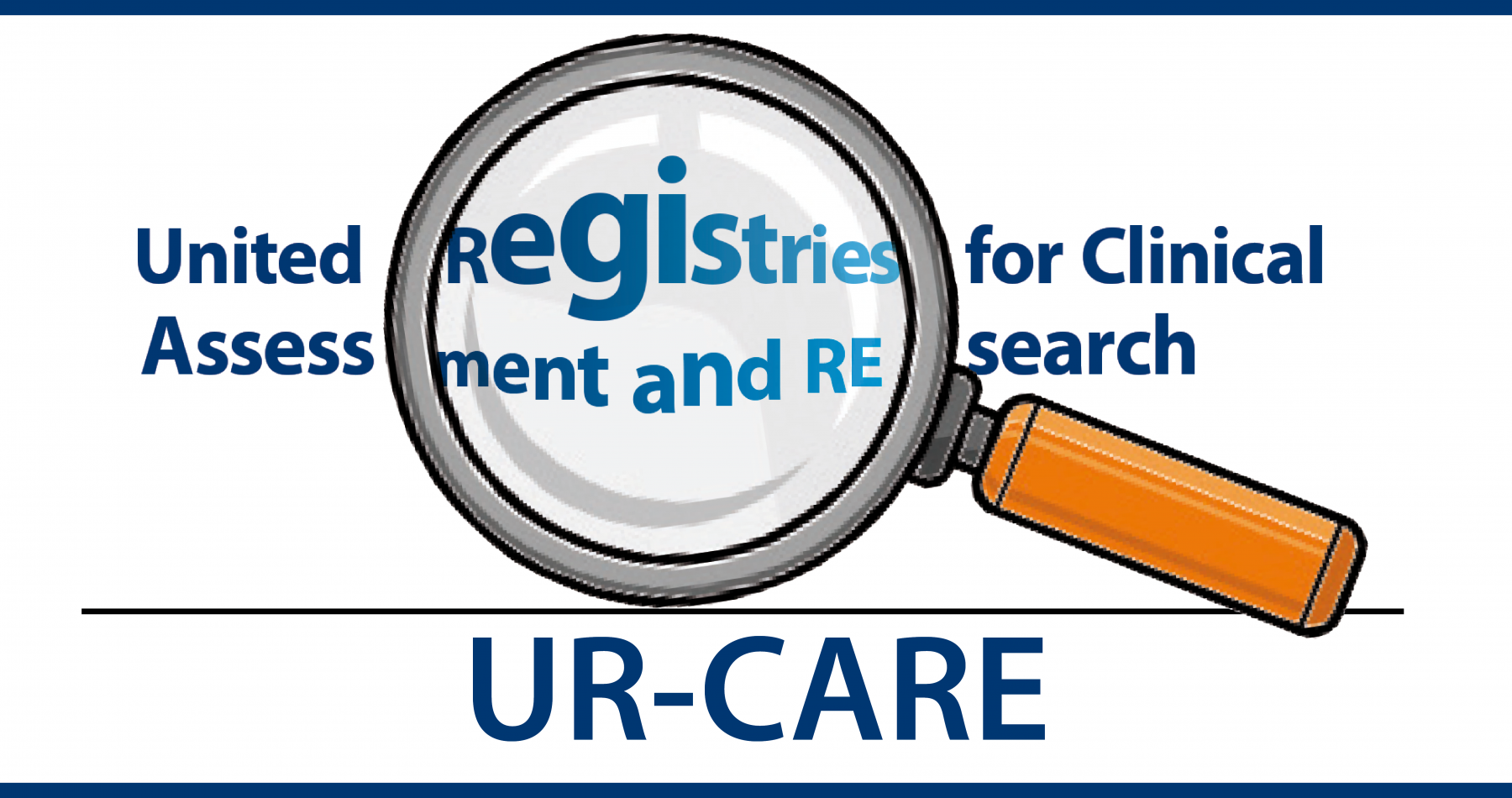Current JCC eTOC
Current JCC eTOC

Please find here the JCC eTOC service, the table of contents for each new issue that is always being updated. Don’t miss this excellent tool for keeping up-to-date on newly published articles.
Journal of Crohn's and Colitis Current Issue
Unravelling the Smoke Trail: Maternal Smoking, Childhood Exposure, and their Impact on Inflammatory Bowel DiseasesMon, 18 Mar 2024 00:00:00 GMT by
The impact of maternal smoking and early life exposure to passive smoking in the development of inflammatory bowel disease [IBD] remains a subject of controversy. In an earlier prospective study in 2007, patients with Crohn’s disease [CD] were more likely to have prenatal smoke exposure than controls (odds ratio [OR] 1.72, 95% confidence interval [CI]; 1.1–2.7) and were also more likely to have passive smoke exposure during childhood, with one or both parents or other household members being smokers [OR 2.04, 95% CI; 1.28–3.31].1 However, a meta-analysis conducted in 2008 by Jones D et al. found no strong association between childhood or prenatal passive smoke exposure and IBD.2 Recently, two noteworthy studies on the impact of maternal smoking during pregnancy [MSDP] and childhood smoking exposure on the development of IBD have been published in the current issue of the journal. The first report, conducted by Linmin Hu et al., is entitled ‘Impact of maternal smoking, offspring smoking, and genetic susceptibility on Crohn’s disease and ulcerative colitis’.3 Another study, titled ‘Tobacco smoke exposure in early childhood and later risk of inflammatory bowel disease’ was conducted by Ida Sigvardsson et al. Both reports emphasise the importance of understanding early life exposure to passive smoking in the development of IBD.4Read more
Tobacco Smoke Exposure in Early Childhood and Later Risk of Inflammatory Bowel Disease: A Scandinavian Birth Cohort StudyThu, 08 Feb 2024 00:00:00 GMT by
Abstract
Objectives
To examine the association between early-life smoking exposure and later risk of inflammatory bowel disease [IBD].Methods
We followed 115663 participants from the Norwegian Mother, Father and Child [MoBa] and All Babies in Southeast Sweden [ABIS] cohorts from birth [1997–2009] through 2021. IBD was identified through national patient registers. Validated questionnaire data defined maternal smoking during pregnancy, maternal environmental tobacco smoke [ETS] exposure during pregnancy, and child ETS exposure by ages 12 and 36 months. Cox regression was used to estimate adjusted hazard ratios [aHRs] for sex, maternal age, education level, parental IBD, and origin. Cohort-specific estimates were pooled using a random-effects model.Results
During 1 987 430 person-years of follow-up, 444 participants developed IBD [ABIS, 112; MoBa, 332]. Any vs no maternal smoking during pregnancy yielded a pooled aHR of 1.30 [95% CI = 0.97–1.74] for offspring IBD. Higher level of maternal smoking during pregnancy (compared with no smoking, average ≥6 cigarettes/day: pooled aHR = 1.60 [95% CI = 1.08–2.38]) was associated with offspring IBD, whereas a lower smoking level was not (average 1–5 cigarettes/day: pooled aHR = 1.09 [95% CI = 0.73–1.64]). Child ETS exposure in the first year of life was associated with later IBD (any vs no ETS, pooled aHR = 1.32 [95% CI = 1.03–1.69]). Estimates observed for child ETS exposure by 36 months were similar but not statistically significant.Conclusions
In this prospective Scandinavian cohort study, children exposed to higher levels of maternal smoking during pregnancy or ETS during the first year of life were at increased risk of later IBD.Read more
Efficacy and Safety of the Anti-mucosal Addressin Cell Adhesion Molecule-1 Antibody Ontamalimab in Patients with Moderate-to-Severe Ulcerative Colitis or Crohn’s DiseaseThu, 14 Dec 2023 00:00:00 GMT by
Abstract
Background and Aims
Ontamalimab is a fully human immunoglobulin G2 monoclonal antibody against mucosal addressin cell adhesion molecule-1, developed as treatment for inflammatory bowel disease.Methods
Six phase 3, multicentre, randomised, double-blind, placebo-controlled clinical trials compared efficacy and safety of ontamalimab [25 mg and 75 mg once every 4 weeks] with placebo in patients with moderate-to-severe ulcerative colitis or Crohn’s disease [two induction studies and one re-randomised maintenance study per condition]. This clinical trial programme was discontinued in 2020 for reasons unrelated to drug safety/efficacy; Crohn’s disease studies are described in the Supplementary data.Results
The induction [12-week] and maintenance [52-week] studies included 659 and 366 randomised patients, respectively. More patients who received ontamalimab induction than placebo achieved the primary endpoint of clinical remission at Week 12 [25 mg, 18.5% vs 15.8%, p = 0.617, 27.0% vs 12.5%, p = 0.027; 75 mg, 29.8% vs 15.8%, p = 0.018, 29.5% vs 12.5% p = 0.014]; significantly more patients who received ontamalimab maintenance therapy than placebo achieved Week 52 clinical remission [25 mg, 53.5% vs 8.2%, p <0.001; 75 mg, 40.2% vs 12.8%, p <0.001]. Endoscopic improvement was generally significantly different vs placebo [induction: 25 mg, 27.8% vs 21.1%, p = 0.253, 35.1% vs 12.5%, p = 0.001; 75 mg, 41.1% vs 21.1%, p = 0.002, 33.9% vs 12.5%, p = 0.003; maintenance: 25 mg, 56.3% vs 9.6%, p <0.001; 75 mg, 48.8% vs 15.1%, p <0.001]. Adverse event rates were similar between ontamalimab and placebo groups.Conclusions
Ontamalimab 75 mg was effective, with no safety concerns, as induction and maintenance therapy for patients with moderate-to-severe ulcerative colitis. [NCT03259334; NCT03259308; NCT03290781; NCT03559517; NCT03566823; NCT03627091]Read more
Impact of Maternal Smoking, Offspring Smoking, and Genetic Susceptibility on Crohn’s Disease and Ulcerative ColitisFri, 01 Dec 2023 00:00:00 GMT by
Abstract
Background and Aims
The long-term impact of maternal smoking during pregnancy [MSDP] on the risk of Crohn’s disease [CD] and ulcerative colitis [UC] in adult offspring remains uncertain. The present study aimed to investigate the individual and combined effects of early life exposure [MSDP], offspring personal behaviour [smoking], and genetic risk on the development of CD and UC in adult offspring.Methods
We conducted a prospective cohort study using UK Biobank data, including 334 083 participants recruited between 2006 and 2010, with follow-up until December 31, 2021. Multivariable Cox regression models were used to evaluate the associations of genetic factors, maternal and personal smoking, and their combination with CD and UC.Results
Participants exposed to MSDP had an 18% increased risk of CD compared to those without MSDP (hazard ratio [HR] = 1.18, 95% confidence interval [CI] = 1.01–1.39). However, no significant association was found between MSDP and UC risk [HR = 1.03, 95% CI = 0.92–1.16]. Personal smoking increased the risk of CD and UC, and had a numerically amplified effect with MSDP. Participants with high genetic risk and MSDP had a 2.01-fold [95% CI = 1.53–2.65] and a 2.45-fold [95% CI = 2.00–2.99] increased risk of CD and UC, respectively, compared to participants without MSDP and with low genetic risk.Conclusions
Our prospective cohort study provides evidence that MSDP increases the risk of CD in adult offspring, whereas no evidence supports their causal association. Additionally, smoking and genetic susceptibility had a numerically amplified effect with MSDP on CD and UC, but the interaction lacked statistical significance.Read more
Improved Clinical Outcomes With Early Anti-Tumour Necrosis Factor Alpha Therapy in Children With Newly Diagnosed Crohn’s Disease: Real-world Data from the International Prospective PIBD-SETQuality Inception Cohort StudyMon, 27 Nov 2023 00:00:00 GMT by
Abstract
Background and Aims
Treatment guidelines for paediatric Crohn’s disease [CD] suggest early use of anti-tumour necrosis factor alpha [anti-TNFα] in high-risk individuals. The aim is to evaluate the effect of early anti-TNF in a real-world cohort.Methods
Children with newly diagnosed CD were prospectively recruited at 28 participating sites of the international observational PIBD-SETQuality study. Outcomes were compared at 3 months, 1 and 2 years between patients receiving early anti-TNF [<90 days after diagnosis] and those not receiving early anti-TNF. Outcomes included sustained steroid-free remission [SSFR] without treatment intensification [specified as SSFR*] and sustained steroid-free mild/inactive disease without treatment intensification [specified as SSFMI*]. Penalised logistic regression model-based standardisation was applied to estimate the relative risks [RR] of early therapy on outcomes. RRs were estimated for high-risk and low-risk patients, based on presence of predictors of poor outcome [POPOs] and disease activity at diagnosis.Results
In total, 331 children (median age 13.9 years [IQR 12.2–15.3]) were enrolled, with 135 [41%] receiving early anti-TNF. At 1 year, patients on early anti-TNF had higher rates of SSFR* [30% vs 14%, p <0.001] and SSFMI* [69% vs 33%, p <0.001], with RRs of 2.95 [95% CI 1.63-5.36] and 4.67 [95% CI 2.46-8.87], respectively. At 1 year, the RRs for SSFMI* were higher, and statistically significant in high-risk patients, i.e. those with moderate/severe disease compared with mild/inactive disease at diagnosis (5.50 [95% CI 2.51-12.05] vs 2.91 [95% CI 0.92-9.11]), and those with any POPO compared with no POPO (5.05 [95% CI 2.45-10.43] vs 3.41 [95% CI 0.54-21.7]).Conclusion
In this cohort of children with newly-diagnosed CD, early anti-TNF demonstrated superior effectiveness in high-risk patients.Read more
The Role of Platelets and von Willebrand Factor in the Procoagulant Phenotype of Inflammatory Bowel DiseaseMon, 27 Nov 2023 00:00:00 GMT by
Abstract
Aims
Although the risk of thrombosis is well documented for inflammatory bowel disease [IBD] patients, the underlying pathological mechanism seems to be different from other thrombotic conditions. Determining the factors responsible for the increased risk of thrombosis in IBD would help to improve the management of this frequent complication.Methods
We studied the interplay between platelets, coagulation, and von Willebrand factor [VWF] in 193 IBD patients and in experimental models [acute and chronic] of colitis in wild-type and VWF-deficient mice.Results
We found a platelet-dependent increase in thrombin generation in IBD patients and in our mouse model of colitis. Agglutinated platelets were present in the blood of patients and mice. Interestingly, we observed not only a significant increase in total VWF antigen, but we were also able to detect the presence of active VWF [VWF in its platelet-binding conformation; 3.2 ± 2.7 μg/mL] in the plasma of 30% of all IBD patients. In healthy controls, active VWF levels were <0.3 μg/mL. This led us to further explore experimental colitis in VWF-deficient mice and we observed that these mice were protected against the procoagulant state triggered by the colitis. Unexpectedly, these mice also showed a significant worsening of colitis severity in both acute and chronic models.Conclusion
Platelets and VWF [including its active form] appear to be central players in the procoagulant phenotype in IBD. We observed that the role of VWF in haemostasis differs from its role in colonic tissue healing, potentially opening new therapeutic avenues for a life-threatening complication in IBD patients.Read more
Histological Image-based Ensemble Model to Identify Myenteric Plexitis and Predict Endoscopic Postoperative Recurrence in Crohn’s Disease: A Multicentre, Retrospective StudyFri, 24 Nov 2023 00:00:00 GMT by
Abstract
Background and Aims
Myenteric plexitis is correlated with postoperative recurrence of Crohn’s disease when relying on traditional statistical methods. However, comprehensive assessment of myenteric plexus remains challenging. This study aimed to develop and validate a deep learning system to predict postoperative recurrence through automatic screening and identification of features of the muscular layer and myenteric plexus.Methods
We retrospectively reviewed 205 patients who underwent bowel resection surgery from two hospitals. Patients were divided into a training cohort [n = 108], an internal validation cohort [n = 47], and an external validation cohort [n = 50]. A total of 190 960 patches from 278 whole-slide images of surgical specimens were analysed using the ResNet50 encoder, and 6144 features were extracted after transfer learning. We used five robust algorithms to construct classification models. The performances of the models were evaluated based on the area under the receiver operating characteristic curve [AUC] in three cohorts.Results
The stacking model achieved satisfactory accuracy in predicting postoperative recurrence of CD in the training cohort (AUC: 0.980; 95% confidence interval [CI] 0.960–0.999), internal validation cohort [AUC: 0.908; 95% CI 0.823–0.992], and external validation cohort [AUC: 0.868; 95% CI 0.761–0.975]. The accuracy for identifying the severity of myenteric plexitis was 0.833, 0.745, and 0.694 in the training, internal validation and external validation cohorts, respectively.Conclusions
Our work initially established an interpretable stacking model based on features of the muscular layer and myenteric plexus extracted from histological images to identify the severity of myenteric plexitis and predict postoperative recurrence of CD.Read more
Treatment of Antibiotic Refractory Chronic Pouchitis With JAK Inhibitors and S1P Receptor Modulators: An ECCO CONFER Multicentre Case SeriesWed, 15 Nov 2023 00:00:00 GMT by
Abstract
Background and Aims
Data regarding the effectiveness and safety of Janus kinase [JAK] inhibitors and sphingosine-1-phosphate [S1P] receptor modulators in antibiotic refractory chronic pouchitis [CARP] are lacking.Methods
This ECCO-CONFER project retrospectively collected data for JAK inhibitor or S1P receptor modulator treatments for CARP with at least 3 months of follow-up. The outcomes included corticosteroid- and antibiotic-free clinical response and remission at 3 and 12 months, and trends in modified pouchitis disease activity index [mPDAI], endoscopic PDAI, C-reactive protein, and calprotectin.Results
Seventeen treatments in 15 patients were evaluated. Previous pouchitis treatments included infliximab [5/15], adalimumab [4/15], vedolizumab [9/15], and ustekinumab [5/15]. Pooling data on JAK inhibitors [eight tofacitinib, one filgotinib, and six upadacitinib] after 3 months [T3], steroid- and antibiotic-free clinical response was achieved in 53.3% [8/15], and steroid- and antibiotic-free clinical remission was achieved in 40% [6/15]. Of the patients with at least 12 months of follow-up, steroid- and antibiotic-free clinical response was achieved in 50% [3/6] and remission in one patient [16.7%], endoscopic response in 50% [3/6], and endoscopic remission in 50% [3/6]. Of the two ozanimod treatments at T3, steroid- and antibiotic-free clinical response was achieved in one patient, without remission; both discontinued ozanimod before T12. No side effects were reported.Conclusions
Small molecules may represent a suitable option for CARP refractory to multiple biologics, deserving further investigation.Read more
Kidney Injuries as Extra-intestinal Manifestation of Inflammatory Bowel DiseaseWed, 15 Nov 2023 00:00:00 GMT by
As nephrologists who often see patients with inflammatory bowel disease [IBD] at the request of their gastroenterologist, we read with interest the ECCO Guidelines on Extra-Intestinal Manifestations [EIM] in IBD which you recently published.1 It struck us that the kidney was not even mentioned. Renal involvement was overlooked in a similar way in two other important recent publications about EIM.2,3Read more
Anti-tumor Necrosis Factor Alpha Versus Corticosteroids: A 3-fold Difference in the Occurrence of Venous Thromboembolism in Inflammatory Bowel Disease-A Systematic Review and Meta-analysisSat, 11 Nov 2023 00:00:00 GMT by
Abstract
Background and Aims
Patients with inflammatory bowel disease [IBD] have a more than two fold higher risk of venous thromboembolic events [VTE] than the general population. The aetiology is complex, and the role of medication is not precisely defined. We aimed to assess the effects of anti-tumor necrosis factor alpha [anti-TNFα] drugs and conventional anti-inflammatory therapy, namely corticosteroids [CS], immunomodulators [IM], and 5-aminosalicylates [5-ASA] on VTE in IBD.Methods
A systematic search was performed in five databases on November 22, 2022. We included studies reporting VTE in the distinct categories of medications, determined the proportions, and calculated the odds ratios [OR] with 95% confidence intervals [CI], using the random-effects model. The risk of bias was evaluated with the Joanna Briggs Institute Critical Appraisal Checklist and the Risk of Bias in Non-randomized Studies of Interventions tool.Results
The quantitative analysis included 16 observational studies, with data from 91 322 IBD patients. Patients receiving anti-TNFα medication had significantly less VTE [proportion: 0.05, CI: 0.02–0.10], than patients treated with CS [proportion: 0.16, CI: 0.07–0.32], with OR = 0.42 [CI: 0.25–0.71]. IMs resulted in similar proportions of VTE compared with biologics [0.05, CI: 0.03–0.10], with OR = 0.94 [CI: 0.67–1.33]. The proportion of patients receiving 5-ASA having VTE was 0.09 [CI: 0.04–0.20], with OR = 1.00 [CI: 0.61–1.62].Conclusions
Biologics should be preferred over corticosteroids in cases of severe flare-ups and multiple VTE risk factors, as they are associated with reduced odds of these complications. Further studies are needed to validate our data.Read more
The Safety, Tolerability, Pharmacokinetics, and Clinical Efficacy of the NLRX1 agonist NX-13 in Active Ulcerative Colitis: Results of a Phase 1b StudySat, 11 Nov 2023 00:00:00 GMT by
Abstract
Background and Aims
NX-13 activation of NLRX1 reduces intracellular reactive oxygen species and decreases inflammation in animal models of colitis. A phase 1a trial demonstrated a gut-selective pharmacokinetic profile with good tolerability. This phase Ib study aimed to evaluate the safety, tolerability, and pharmacokinetics of NX-13 in patients with active ulcerative colitis [UC].Methods
We conducted a multicentre, randomized, double-blind, placebo-controlled trial of NX-13 in patients with active UC. Patients with a Mayo Clinic Score of 4–10 were randomly assigned [3:3:3:1 ratio] to three NX-13 oral dose groups (250 mg immediate release [IR], 500 mg IR, or 500 mg delayed release [DR], or placebo) once daily for 4 weeks. Safety and pharmacokinetics were the primary and secondary objectives, respectively.Results
Thirty-eight patients [11 females] were recruited and randomized to placebo [five], NX-13 250 mg IR [11], NX-13 500 mg IR [11], or NX-13 500 mg DR [11] and received at least one dose. There were no serious adverse events or deaths during the trial. One patient [500 mg DR, 1/11] withdrew due to worsening of UC and a second [500 mg IR, 1/11] on the last day of treatment after a panic attack associated with atrial fibrillation. In the efficacy population [36 patients], clinical improvement in rectal bleeding and stool frequency scores relative to placebo were seen as early as week 2 and endoscopic response was seen at week 4.Conclusions
NX-13 was generally safe and well tolerated with early signs of rapid symptom and endoscopic improvement. This novel mechanism of action warrants further investigation. ClinicalTrials.gov: NCT04862741.Read more
Impact of Baseline Corticosteroid Use on the Efficacy and Safety of Upadacitinib in Patients with Ulcerative Colitis: A Post Hoc Analysis of the Phase 3 Clinical Trial ProgrammeMon, 06 Nov 2023 00:00:00 GMT by
Abstract
Background and Aims
This post hoc analysis assessed the efficacy and safety of upadacitinib in patients with moderately to severely active ulcerative colitis stratified by corticosteroid use from the ulcerative colitis Phase 3 clinical trial programme.Methods
Patients were randomised [1:2] to 8 weeks’ placebo or upadacitinib 45 mg once daily; Week 8 responders were re-randomised [1:1:1] to 52 weeks’ placebo or upadacitinib 15 or 30 mg daily. Corticosteroid dose was kept stable during induction but tapered according to a protocol-defined schedule [or investigator discretion] during maintenance Weeks 0–8. Efficacy outcomes and exposure-adjusted, treatment-emergent adverse event [TEAE] rates were assessed for induction and maintenance stratified by corticosteroid use at induction baseline.Results
Overall, 377/988 [38%] patients were receiving corticosteroids at induction baseline [placebo, n = 133; upadacitinib 45 mg, n = 244] and 252 [37%] of the 681 clinical responders who entered maintenance were on corticosteroids at induction baseline [n = 84 for each treatment]. Similar proportions of patients receiving upadacitinib achieved clinical remission per Adapted Mayo Score with and without baseline corticosteroids at Weeks 8 and 52. The total proportion of patients re-initiating corticosteroids was higher with placebo [24/84;29%] vs upadacitinib 15 mg [16/81; 20%)] and 30 mg [11/81; 14%]. During induction, patients receiving corticosteroids at baseline had higher rates of TEAEs, serious TEAEs, and serious infections vs those not receiving corticosteroids; however, TEAE rates were similar during maintenance after corticosteroid withdrawal.Conclusions
Upadacitinib is an effective steroid-sparing treatment in patients with moderately to severely active ulcerative colitis. Clinicaltrials.gov identifiers: NCT02819635; NCT03653026Read more
Cancer Biology or Ineffective Surveillance? A Multicentre Retrospective Analysis of Colitis-Associated Post-Colonoscopy Colorectal CancersMon, 06 Nov 2023 00:00:00 GMT by
Abstract
Background and Aims
Inflammatory bowel disease [IBD] is associated with high rates of post-colonoscopy colorectal cancer [PCCRC], but further in-depth qualitative analyses are required to determine whether they result from inadequate surveillance or aggressive IBD cancer evolution.Methods
All IBD patients who had a colorectal cancer [CRC] diagnosed between January 2015 and July 2019 and a recent [<4 years] surveillance colonoscopy at one of four English hospital trusts underwent root cause analyses as recommended by the World Endoscopy Organisation to identify plausible PCCRC causative factors.Results
In total, 61% [n = 22/36] of the included IBD CRCs were PCCRCs. They developed in patients with high cancer risk factors [77.8%; n = 28/36] requiring annual surveillance, yet 57.1% [n = 20/35] had inappropriately delayed surveillance. Most PCCRCs developed in situations where [i] an endoscopically unresectable lesion was detected [40.9%; n = 9/22], [ii] there was a deviation from the planned management pathway [40.9%; n = 9/22], such as service-, clinician- or patient-related delays in acting on a detected lesion, or [iii] lesions were potentially missed as they were typically located within areas of active inflammation or post-inflammatory change [36.4%; n = 8/22].Conclusions
IBD PCCRC prevention will require more proactive strategies to reduce endoscopic inflammatory burden, and to improve lesion optical characterization, adherence to recommended surveillance intervals, and patient acceptance of prophylactic colectomy. However, the significant proportion appearing to originate from non-adenomatous-looking mucosa which fail to yield neoplasia on biopsy yet display aggressive cancer evolution highlights the limitations of current surveillance. Emerging molecular biomarkers may play a role in enhancing cancer risk stratification in future clinical practice.Read more
Higher Serum Infliximab Concentrations Following Subcutaneous Dosing are Associated with Deep Remission in Patients with Inflammatory Bowel DiseaseThu, 02 Nov 2023 00:00:00 GMT by
Abstract
Background
The relationship between subcutaneous infliximab [SC-IFX] concentrations and favourable therapeutic outcomes in patients with Crohn’s disease [CD] and ulcerative colitis [UC] remains elusive.Patients and Methods
This cross-sectional study included consecutive adult patients with inflammatory bowel disease [IBD] treated with SC-IFX at a maintenance dose of 120 mg/2 weeks. Investigated therapeutic outcomes included sustained clinical remission; composite clinical and biomarker remission [clinical remission and C-reactive protein <5 mg/L]; biochemical remission [faecal calprotectin <250 µg/g]; and deep remission [clinical, biological, and biochemical remission].Results
Of 91 patients identified, 71 qualified for inclusion in the study [70% with CD; 27% with concomitant immunomodulators]. At the time of drug concentration measurement [median 13.5 months after switch], 55 [77%] patients had sustained clinical remission; n = 44 [62%] composite clinical and biomarker remission; n = 40 [56%] biochemical remission; and n = 31 [43%] deep remission. The mean SC-IFX concentrations were significantly higher in patients with sustained clinical remission [p = 0.014]; composite clinical and biomarker remission [p = 0.003]; biochemical remission [p < 0.001]; and deep remission [p < 0.001] compared to patients without having these outcomes. In multivariate analysis, SC-IFX concentration was the only factor independently associated with sustained clinical remission (odds ratio [OR]: 4.7, 95% confidence interval [CI]: 3.1–12.2, p = 0.005); clinical and biomarker remission [OR: 9.21, 95% CI: 6.09–18.7, p = 0.006]; biochemical remission [OR: 37, 95% CI: 14–39.3, p < 0.001]; and deep remission [OR: 29, 95% CI: 15.7–37.4, p < 0.001]. The optimal SC-IFX concentration cut-off associated with deep remission based on ROC analysis was 20 µg/mL [sensitivity: 0.91, specificity: 0.80, accuracy: 0.85]. Combination with an immunomodulator failed to improve SC-IFX pharmacokinetics.Conclusion
Higher SC-IFX concentrations are associated with higher rates of favourable therapeutic outcomes in IBD patients. Serum SC-IFX concentrations >20 µg/mL were significantly associated with deep remission.Read more




